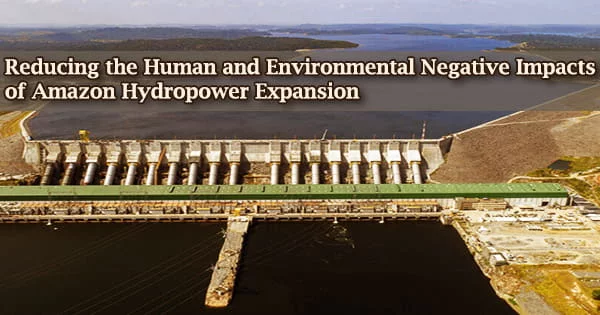Rapid electrical dam construction in the Amazon is putting the world’s largest and most biodiverse river basin in jeopardy. In the Amazon River basin, there are 158 dams, with 351 more proposed; these projects are normally examined individually, with minimal coordination.
The first computational approach for analyzing basin-level tradeoffs between hydropower and ecological services is published today in Science, with the goal of guiding sustainable dam placement.
Coauthor Stephen Hamilton, an ecosystem ecologist at Cary Institute of Ecosystem Studies explains, “Continued hydropower development in the Amazon is inevitable. So how can that proceed in a way that optimizes energy output at the lowest environmental cost? The answer comes in selecting projects strategically, taking into account multiple environmental criteria that have thus far been too difficult to account for simultaneously in planning large numbers of potential projects.”
Hamilton was part of an interdisciplinary team of environmental and computational experts who created ‘Amazon EcoVistas,’ a new framework for analyzing proposed dam projects collectively for both energy generation and environmental implications.
They looked at river flow, river connectivity, sediment movement, fish biodiversity, and greenhouse gas emissions, among other things. Their program identifies hydroelectric dam portfolios that achieve energy production targets while causing the least environmental harm using artificial intelligence and high-performance computation.
“Our tool allows us to evaluate hydroelectric projects for their collective impacts to nature and people on the scale of the entire watershed a rare, yet critical approach, since the Amazon River and its tributaries flow through multiple countries with diverse topography,” explains coauthor Rafael Almeida, a former visiting graduate student at Cary who is currently an Assistant Professor at the University of Texas, Rio Grande Valley.
Hydroelectric energy planning typically happens on a national basis, even though electricity is exported across borders. Our evaluations demonstrate that coordinated whole-basin planning can reduce environmental impacts while optimizing energy production and maintaining crucial ecosystem services.
Stephen Hamilton
The tool can also screen out particularly harmful projects, with Almeida adding, “Fragmentation of river systems, blockage of fish migrations, trapping of sediment, and emission of methane are all worsened by the absence of basin-wide planning.”
Almeida points out that the environmental parameters considered have social implications as well. Dams obstruct the flow of sediments needed to nourish floodplain agricultural crops. Fishery deterioration jeopardizes a vital source of food and revenue, while river fragmentation obstructs people and goods mobility.
The ‘Amazon EcoVistas’ algorithm was used to build scenarios based on all potential combinations of the 158 current and 351 projected dams. This enables it to determine the ‘Pareto-optimal frontier,’ or hydropower project combination that minimizes negative environmental effects for any given amount of aggregate hydropower output.
This process is extremely computationally intensive; between the 509 total projects, there are 2509(or ~10153) possible combinations with six dimensions (energy output + the five environmental criteria) evaluated for each.
Lead author Alexander Flecker, Professor in the Department of Ecology and Evolutionary Biology at Cornell University, says, “All decisions around dam siting involve complex tradeoffs. The Pareto-optimal frontier provides a clear way to evaluate those tradeoffs as we seek to balance energy production and diverse environmental consequences.”
Dams in high Andean valleys of upper Amazon rivers, for example, create smaller reservoirs, inundating less area and emitting less methane. Dams erected higher in the river system also cause less disruption for fish that need to move large distances, but dams built lower in the system prevent fish from reaching the river’s upstream reaches.
Andean dams, on the other hand, retain mountain sediments that are needed to feed downstream ecosystems and sustain crucial floodplains for people and wildlife. Dams in steep valleys are also more likely to hold water at higher flows, causing more disruptive changes in downstream flows.
Flecker continues, “There’s no one-size-fits-all solution to minimize negative environmental impacts of dam construction. But the most damaging impacts can be averted by weighing the various ecological and social costs of different combinations of projects. Our novel computational framework is the first to make this kind of evaluation possible on such a vast basin-wide scale.”
“Applying our method to existing dams in the Amazon shows how a lack of coordinated planning to date has resulted in projects that are collectively more harmful than would have been the case had alternative, strategically selected portfolios of dams been built,” Almeida explains.
“This is true for all five criteria that we evaluated. Planning across borders would benefit all countries in the region both in terms of meeting energy needs and facilitating better environmental outcomes.”
‘Amazon EcoVistas’ could be valuable to energy planners, decision makers, and researchers trying to implement strategic, whole-basin dam design by identifying potential for more sustainable hydropower development. It could also aid in determining dam removal priorities in areas with older dams, such as North America and Europe.
Hamilton concludes, “Hydroelectric energy planning typically happens on a national basis, even though electricity is exported across borders. Our evaluations demonstrate that coordinated whole-basin planning can reduce environmental impacts while optimizing energy production and maintaining crucial ecosystem services.”





